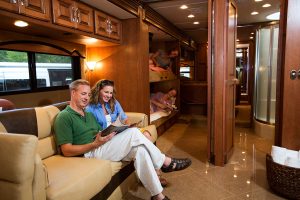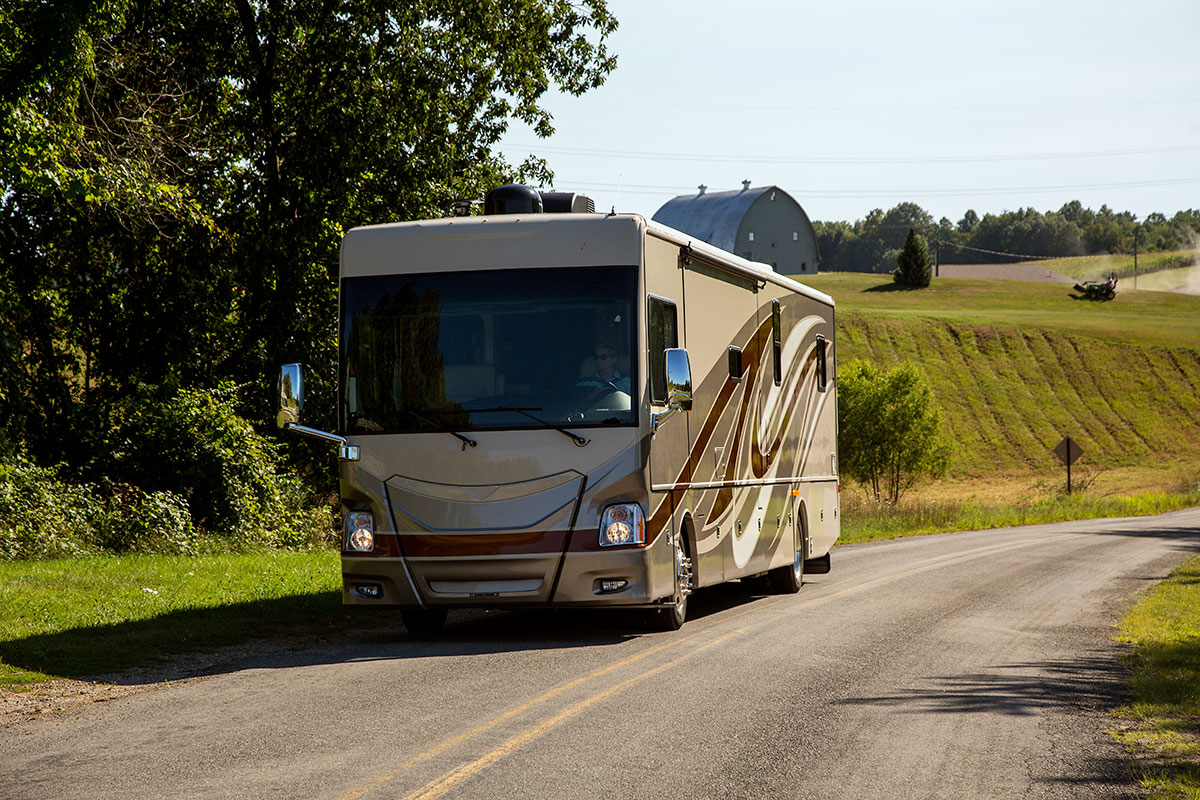Any RV purchase is a big investment, and not just in dollars. You’re also investing in the RV lifestyle, of spending your weekends and holiday vacations camping or traveling with your trusty home away from home. One of the largest types of RV is a Class A or conventional motorhome, which is built on a specialty bus or truck chassis. It’s transportation and a home all rolled into one. It usually has a lot of bells and whistles, ranging from gourmet kitchens, larger bathrooms, roomy living quarters, and WiFi capability.
Do I need special credentials to drive a motorhome?
Typically, you do not need a CDL (commercial driver’s license) or any other credentials. However, it’s a good idea to check your state’s laws just in case, especially if the RV you’re considering utilizes air brakes or exceeds certain weight thresholds.
How large are Class A motorhomes?
Conventional motorhomes can be 21-40 feet long and cost $60,000 to more than $500,000 new off the lot. They are generally spacious, well-equipped, and offer plenty of storage. Some Class A motorhomes have motorized slide-outs, with some models moving an RV wall outward up to three feet to add even more space. Obviously, the size of these motorhomes can make it difficult to pass under some bridges, navigate narrow towns, or park at a popular destination, which is why many owners opt to tow a small car behind for side trips.
What about the gas mileage?
It should come as no surprise that gas mileage isn’t pretty on such large vehicles. Larger motorhomes will consume more gas than smaller motorhomes. Loaded motorhomes will consume even more gas. On average, conventional motorhomes run at 8-13 mpg. To be a savvy spender, you can choose to camp close to home or stay in one spot for the duration of your vacation and use a small car for any other exploration. If you’re looking for fuel economy, check out Class B motorhomes, also known as camper vans.
How will I be able to choose?
RV shows, which typically take place in the fall and winter seasons, are a great option to see a lot of models by a lot of different manufacturers all in one place. You can talk to the sales folks about any model you’re interested in. Many offer special financing as a part of the show. However, it pays to do your research before the show so that you know what you’re looking for as far as budget, size, layout, and equipment. Do your research after the show, too, if an RV catches your eye. Choosing a Class A RV is a big investment, so make your decision carefully and selectively.
Can I deduct any part of my motorhome on my taxes?
The answer to this question is yes! It can be considered a second dwelling, so you can write off interest on your loan payment as well as taxes paid on the initial payment. As with standard vehicles, you can deduct the cost to renew and register your plates.
 Do I need to follow truck speeds on the highway?
Do I need to follow truck speeds on the highway?
RVs, even long Class A motorhomes, are classified as non-commercial vehicles. This means you can follow all normal car speed limits.
Does everybody need to wear a seat belt while traveling?
Seat belts save lives. The law varies depending on the state. In Michigan children ages 4-15 and anyone sitting in the front of the motorhome (driver and “copilot”) are required to wear seat belts or incur a fine. Children in booster or car seats should be forward facing – not on a side couch or bench – and on a seat that is bolted well to the floor of the RV. This isn’t always the case with RV design.
How can I ensure that traveling and camping in a large rig will go smoothly?
In a word, practice. Seasoned RVers who own this type of RV make it look easy because they’ve camped and traveled in a large RV many times before. Yet, they can still have their share of snags. If you’re new to owning a Class A motorhome, then you’ll want some time to get used to it before you depart on your first adventure. Practice cornering, backing up, and towing (if you’ll be bringing a toad for off-campsite excursions). An empty parking lot can be a good place to practice. Take the RV for a spin on the highway, too, if you’re able, to get used to how the RV feels when you’re braking, accelerating, and driving in general. Large motorhomes take more time to speed up and more time to stop. They are heavy and bulky, but they can still sway on a windy day. Plus, the faster you go, the more difficult your RV will be to control. Watch some videos on YouTube or on RV websites for advice. In everything, whether it’s driving, parking, or setting up or leaving the campsite, the most important thing to do is not rush.

